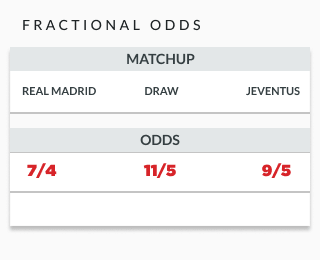How Do Vegas Odds Work
Sports odds, whether you're reading them in your local bricks and mortar venue or on the web, are inevitably influenced by what the bookies are saying in Sin City. Bookies use Vegas odds as a benchmark, meaning there's less variation between gambling venues across the world. Offering odds that are much better for players than Vegas odds will certainly attract more gamblers, but it can be disastrous for.
- Many books will give you the odds on a game with one team on top of another, while others may list one team on the left and the other on the right. Whatever the case may be the first team listed is always the visitor and the second is the home club. The first thing you’ll see will be the date and time of the game.
- For instance, a $1 bet with +1000 odds will return $11 on a winning bet. This is the standard display for most sports, including NFL odds and NBA odds. Fractional style shows as one number over another number. For example, you might see bet365 odds at 10/1.
This guide will help you understand how betting odds work.
There are 3 different kinds of betting odds; Fractional, Decimal and American. American odds are often called Moneyline odds.
[divider]
HOW DO DECIMAL BETTING ODDS WORK?
Decimal odds are the easiest type of odds to understand.
To calculate your winnings using decimal odds, simply multiply your [tooltip text=”stake” gravity=”n”]Your “Stake” is the amount of money you wish to bet[/tooltip] by the decimal number. For example…
If you placed a $10 bet at odds of 2.00, you would simply multiply 10 by 2.00 to calculate your return.
10 x 2.00 = 20.00 = $20 return from your $10 bet
How about placing a $15 bet at odds of 1.57?
15 x 1.57 = 23.55 = $23.55 return from your $15 bet
That was easy wasn’t it?
[divider]
HOW DO AMERICAN [MONEYLINE] ODDS WORK?
American odds are calculated based on how much money you have to bet in order to win $100. The odds are always accompanied by either a plus [+] or minus [-] symbol. The symbols determine whether you need to bet more than $100 (-) or less than $100 (+), to win $100.
This may sound confusing at first, but it’s really not that difficult!
Lets jump right into an example of how American odds work. Remember that American odds are all about how much money you have to bet, in order to win $100.
Imagine the odds looked like this for a particular fight…
Fighter A = -150
Fighter B = +200
When working with American odds, you need to remember that the minus [-] symbol always means that you will have to bet more than $100 to win $100. Minus [-] odds are considered the “favourite”. Odds with the plus [+] symbol are considered the “underdogs”.
If you take a look at the odds above, you can see that Fighter A is the favourite at -150. This means that in order to win $100, you would have to bet $150.
Fighter B on the other hands is a +200 underdog. This means that you would only have to bet $50 to win $100. Here are a couple more examples using more challenging odds…
Fighter A = -600
Fighter B = +1000
In this example Fighter A has odds of -600, which means that you would have to bet $500 to win $100. Fighter B on the other hand has odds of +1000, which means you’d only have to bet $10 to win $100.
Working with American odds will take some getting used to and it can be difficult to work out the exact amount of money you will win from your bets at first.
You can practice working with American betting odds by visiting Best Fight Odds and using an Odds Converter to calculate your returns.
[divider]
HOW DO FRACTIONAL BETTING ODDS WORK?
Fractional betting odds are favoured in the United Kingdom and Ireland and they’e the most popular type of odds used in Horse Racing. Although they may look confusing at first, they’re actually not that hard to work out. Lets jump right into looking at an example of how Fractional odds work…
If you wanted to bet $50 at odds of 6/4 six to four, this is how you would work it out:
First you have to add the numbers of the fraction together, in this case it would be 6 + 4 = 10. Then divide this number by the second number, in this case 4. 10 divide by 4 = 2.5. Then multiply this number by your stake. 2.5 x 50 = 125. Your return for a $50 bet at odds of 6/4 would be $125.


(6+4 = 10) 10 divided by 4 = 2.5
2.5 x 50(stake)= £125
If you get stuck and you’d like some help calculating how betting odds work, please don’t hesitate to get in touch.
Understanding Sports OddsNCAA Football Betting Terms
Action: A bet of any kind.
ATS: Abbreviation for Above the Spread
Back-door Cover: This term refers to meaningless points scored late in the game by the underdog team to cover the spread.
Book: A sportsbook or a betting establishment that offers odds and accepts wagers.
Bookie: A person (or establishment) that takes bets on the outcome of sporting events.
Cover: If you beat the spread by the required number of points, you’ve ‘covered’ the spread.
Edge: This is the advantage in any wager.
Favorite: This is the team that is expected to win.
Front-door Cover: This is the opposite of Back-door cover. It is used in reference to the favored team scoring meaningless points late in the game to cover the spread.

Futures bet: This refers to placing a bet on any future event in the season. For example, putting down a bet early in the football season for who will win a bowl game.
Handicapper: This is a person who studies and rates sporting events.
Handicapping: This is when someone tries to predict the outcome of any given game.
Home field advantage: The edge a team is supposed to have when they play on their home field. Since the home field is a familiar turf and in front of the home crowd, teams are expected to perform better than they would if they were travelling thus giving them an edge.
Hook: This is a half point added to football odds.
Line: This is the odds, points, money line, or point spread offered on football games.
Linemaker: This is someone that sets the odds, points, money lines, or point spreads for football games.
Lock: This term is used to refer to an easy win.
Longshot: This is a term used to refer to an extreme underdog.
Moneyline: This refers to the amount of money a player must wager in order to win $100, or the amount of money a player wins if they put $100 on the underdog.
Oddsmaker: This is another term for the Linemaker. It is the person who sets the odds, moneyline, or point spread for football games.
Over/Under Bets: This refers to a bet on whether the combined total of the points scored by both teams will be more or less than a set number.
Overlay: This is a term to refer to odds that are higher than they should be. These odds favor the bettor not the house.
Parlay: This is a wager on two or more teams or outcomes where the selections must win in order for the bettor to win.
How Do Odds Work Betting
Past performance: This refers to any given team’s results in past seasons. This is particularly important when betting on NCAA football.
Player: This is a term that refers to any person that puts down a bet on any given sports event.
How Do Vegas Odds Work College Football
Point Spread: This is a number of points given to the underdog by the Linemaker in order to handicap the favorite. It can also be thought of in terms of the scoring differential between the two teams. The point spread is used to even the playing field.
How Do Las Vegas Odds Work
Proposition Bet or Props: This is a bet placed on a specific aspect of the game, such as who will score first or how long the longest touch down pass will be.
Soft line: This refers to a line that has been adjusted because of the result of an action. It is not the true posted line.
How Do Vegas Odds Work
Underdog: This is a term that refers to the team that is expected to lose.
Las Vegas Sports Odds
Underlay: This is a term that refers to odds that lower than they should be. These odds favor the house and not the bettor.